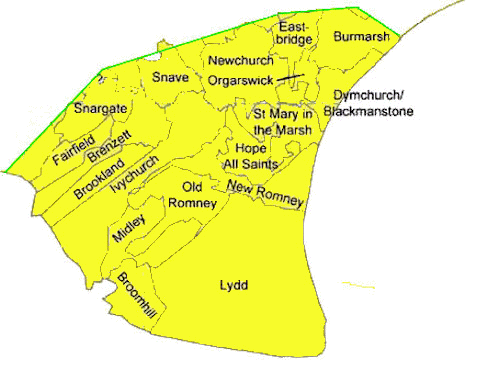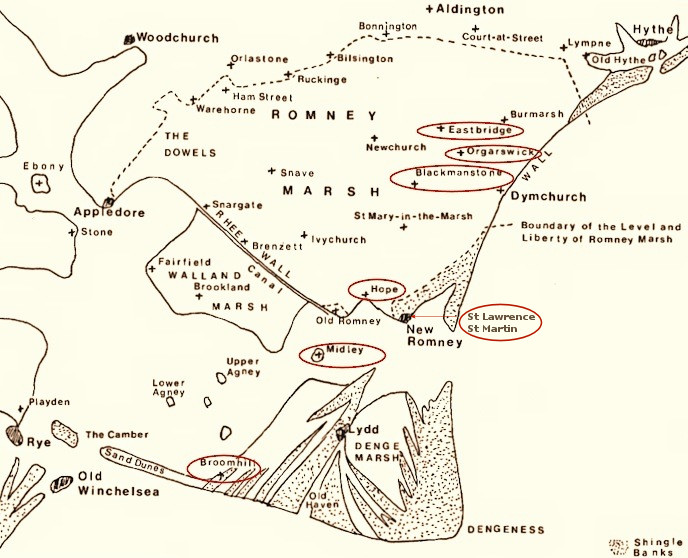Lost Villages of Romney Marsh
Today (2022) there are seventeen. See our Villages pages.
Over time there have been twenty-eight villages/parishes, including the two towns of New Romney and Lydd, existing on Romney Marsh. Today (2020) there are seventeen. See our Villages pages.
Some of these lost communities on the Marsh are instances of the modern decline of the rural communities. However, the coastal storms in the 13th century, the Black Death in 1348–50 and Malaria, which was present across the Romney Marsh from 1500 to 1730, help cause the disappearance over time of many hamlets and small communities across the Romney Marsh.
The map on the right, based on The Tithe Commutation surveys carried out from the 1830s to 1840s, shows the location of the current and old parishes of Romney Marsh, with the information below about the lost villages/parishes.
![]() see also Lost Churches of Romney Marsh and Lost Villages as described in 1799.
see also Lost Churches of Romney Marsh and Lost Villages as described in 1799.
Blackmanstone - West of Dymchurch, northeast from Orgarswick; mentioned in the Domesday Book. Abolished as a civil parish in 1934 to become parts of the parishes of Newchurch, Burmarsh, and St. Mary in the Marsh.
 History of Blackmanstone in 1799
History of Blackmanstone in 1799
Broomhill - West of Dungeness; today merely a heap of stones, the village being lost to the sea during raging storms of 1287. It was excavated in the 1980s and was estimated to have been built in 1200AD on the newly drained Walland Marsh.
Originally a port it was a non-corporate Cinque Port, as a limb of New Romney.
 Find out more about the lost villages of Romney Marsh
Find out more about the lost villages of Romney Marsh
as described in 1799 by Edward Hasted

Map showing current and old parishes of Romney Marsh
Dengemarsh - Just south of Lydd; closed when Lydd army ranges were started in WW2. Originally a port it was a non-corporate Cinque Port, as a limb of New Romney.
Eastbridge - West of Dymchurch; mentioned in the Domesday Book. Suffered very badly from the Black Death plague in 1346-53, which almost certainly led to the demise of the village. Today just a couple of houses and the church ruins remain.
 History of Eastbridge in 1799
History of Eastbridge in 1799
Fairfield - West of Brookland; today just the St Thomas a Becket church and a couple of farmhouses remain. Abolished as a civil parish in 1934 to become parts of the parishes of Snargate and Stone cum Ebony.
 History of Fairfield in 1799
History of Fairfield in 1799
Fawkenhurst - West of Dungeness; now just a stone cross on a stepped plinth.
Galloways - Just south of Lydd; closed when Lydd army ranges were started in WW2.
Hope - West of New Romney; abandoned in the 17th Century although a population remained in 884; today just the church ruins remain. Abolished in April 1934 to become parts of the parishes of St. Mary in the Marsh, Newchurch, and Old Romney.
 History of Hope in 1799
History of Hope in 1799

Romney Marsh in the 13th Century Showing the Lost Churches Larger Map
Midley - South west of Old Romney. This was once a small island in the Rother between the larger ones of Romney and Lydd, and the name means "middle island". In the 8th century there was a village on this site. Suffered very badly from the Black Death plague in 1346-53, which almost certainly led to the demise of the village. In 1801 just 23 people still lived here. Now, only the ruined west wall of the church remains.
During World War II, there was an RAF airfield here. Abolished as a civil parish in April 1934 to become part of the parish of Old Romney.
Hope - West of New Romney; abandoned in the 17th Century although a population remained in 884; today just the church ruins remain. Abolished in April 1934 to become parts of the parishes of St. Mary in the Marsh, Newchurch, and Old Romney.
 History of Midley in 1799
History of Midley in 1799
Orgarswick - West of Dymchurch; mentioned in 1851 census and now marked by a cross of stone from the ancient Orgarswick church. Abolished as a civil parish in April 1934 to become part of the parish of Burmarsh.
 History of Orgarswick in 1799
History of Orgarswick in 1799
Oswardstone - Adjacent to Dungeness. Originally a port it was a non-corporate Cinque Port, as a limb of New Romney.
Tours of the Mediaeval Churches
Guided tours of the Romney Marsh churches are available. Please see our Tours of the Mediaeval Churches page.


















